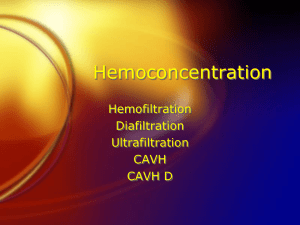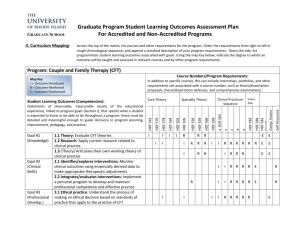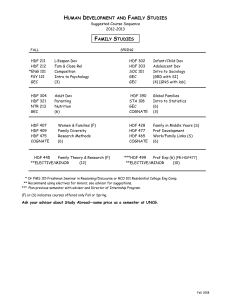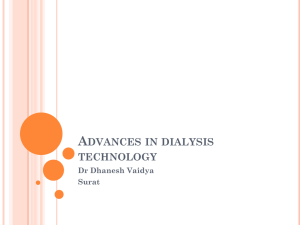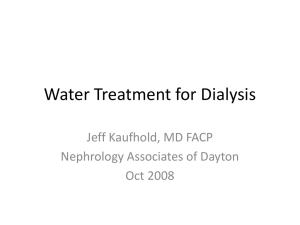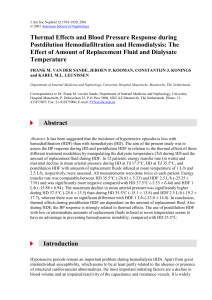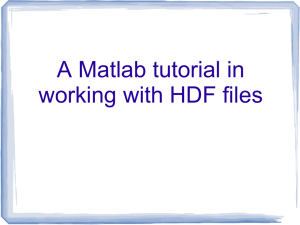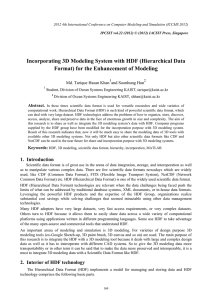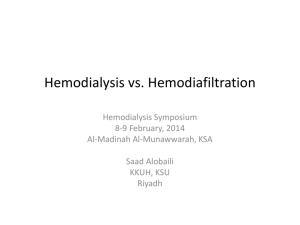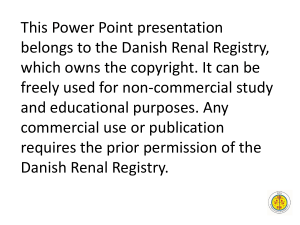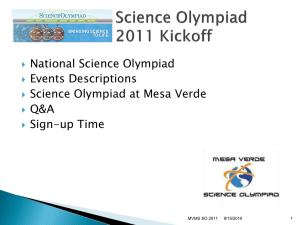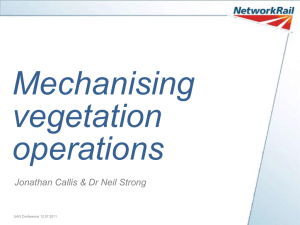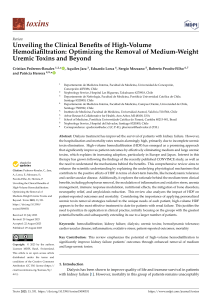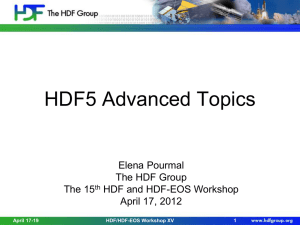HF/HDF
advertisement
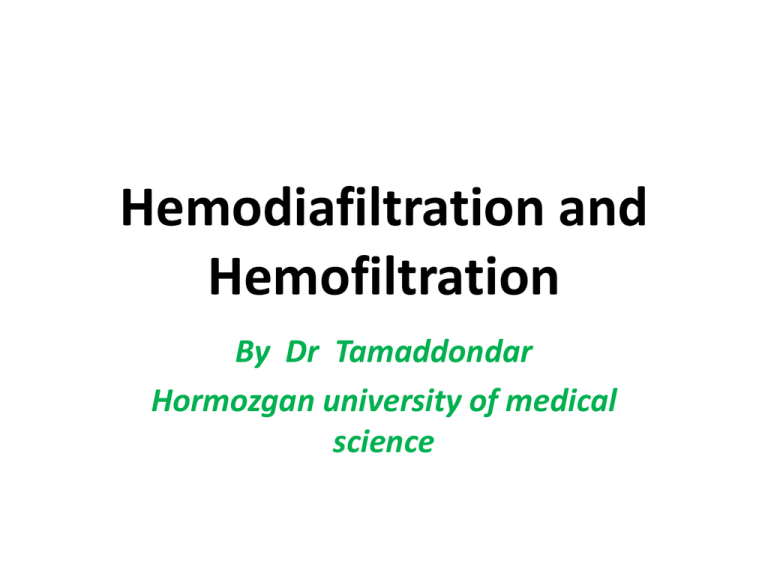
Hemodiafiltration and Hemofiltration By Dr Tamaddondar Hormozgan university of medical science Diffusion V of solution used is 5fold higher than replacement in hemofiltration Convection +/-Diffusion HDF 8 – 15 L HF 20-40L replacement solution • A. Review of diffusion versus convectionbased clearances • B. Hemodiafiltration versus hemofiltration • C. Clearance due to diffusion (dialysis) versus filtration in HDF • D. Predilution versus postdilution mode • E. Technical issues • F.Risk and benefits PORE SIZE PORE SIZE HIGH-PERFORMANCE EXTRACORPOREAL THERAPIES FOR END-STAGE RENAL DISEASE 1-High-efficiency hemodialysis 2-High-flux hemodialysis 3-Hemofiltration(intermittent) 4-Hemodiafiltration( intermittent) Online Hemodiafiltration • Hemodiafiltration permits β2-microglobulin removal and high Kt/V, and is probably the best way to treat chronic renal failure (CRF). Clearance due to diffusion (dialysis) versus filtration in HDF • Ktotal = KDiffusive + F/2 (if UF<100ml/min) Predilution versus postdilution mode • The administration may take place either before (predilution) or after (postdilution) the hemofilter. • Infusing replacement solution in predilution mode in HDF reduces significantly the effect on clearance due to a dilution of the blood entering the dialyzer. Technical issues • Water • Fluid paths(HF/HDF) • Online preparation of replacement solution and dialysis solution • Vascular access • Membrane Water ultrapure water (virtually sterile and nonpyrogenic water) • Current AAMI recommendations <200(CFU)/mL of bacteria <2.0 endotoxin units (EU)/mL of endotoxin • ultrapure dialysis solution<0.1 CFU/mL and <0.03 EU/mL endotoxin • The ultrafilters are replaced periodically to prevent supersaturation and release of endotoxins. Fluid paths(HF/HDF) post-dilution hemofiltration post-dilution hemodiafiltration Online preparation of replacement solution and dialysis solution • Bicarbonate-based dialysate solution is universally used as the starting point. The production of sterile and nonpyrogenic dialysis fluid (ultrapure dialysate) is achieved by “cold sterilization” of the freshly prepared dialysate using an ultrafilter. balancing chamber flow-metric equalizer Infusion module 0-250 mL/min U8000S polyamide S Gambro 3-filter hemodialysis system Diasafe® plus, Polysulfone® FME 2-filter hemodialysis system Vascular access • Patients treated with HF/HDF require an access capable of delivering an extracorporeal blood flow of at least 350 mL per minute, and preferably higher. Membrane Flux • Measure of ultrafiltration capacity • Low and high flux are based on the ultrafiltration coefficient (Kuf) • Low flux: Kuf <10 mL/h/mm Hg • High flux: Kuf >20 mL/h/mm Hg Permeability • Measure of the clearance of the middle molecular weight molecule (eg, β2-microglobulin) • General correlation between flux and permeability • Low permeability: β 2-microglobulin clearance <10 mL/min • High permeability: β 2-microglobulin clearance >20 mL/min Efficiency • Measure of urea clearance • Low and high efficiency are based on the urea KoA value • Low efficiency: KoA <500 mL/min • High efficiency: KoA >600 mL/min Membrane • The membrane should have a high hydraulic permeability (KUF ≥50 mL / hour / mm Hg), high solute permeability (K0A urea >600) and beta2-microglobulin clearance >60 mL/ min), and large surface of exchange (1.50-2.10 m2). Typical prescriptions and substitution fluid infusion rates • The conventional HDF/HF treatment schedule is based on three dialysis sessions per week of 4 hours (12 hours per week). the substitution volume HF • postdilution= Kt/v*55% body weight • predilution= 2*Kt/v*55% body weight Kt/v=1 BW=60KG Pre=60cc/min Post=30cc/min the substitution volume HDF • QB=500ml/min • QD=500-1000ml/min • Typical replacement fluid infusion flow rates= 100 mL/min (24 L for a 4-hour session) in postdilution HDF and 200 mL/min(48 L for a 40-hour session) in predilution HDF mode • simple rule of thumb Pre=1/3*QB Post=1/2*QB Anticoagulation 1-increased sheer forces( activate blood platelets) 2-significant loss or clearance of heparin • The large loss of the initial bolus (>50% for unfractionated heparin (12,000-15,000 daltons) and >80% for low molecular weight heparin (3,000-6,000 daltons • Sample protocol using LMWH • Lovenox 0.5 mg/kg body weight or 50 IU/kg body weight ,Allow to systemically circulate 34 minutes before starting treatment • No additional LMWH required unless treatment exceeds 4 hours If >4 hours inject 400 IU at mid point of treatment via venous injection port unfractionated heparin • Initial bolus 80-100 IU/kg body weight Inject bolus systemically via venous needle allowing 3-5 minutes for circulation of heparin systemically • Continuous infusion of heparin via pump at 25-35 IU/kg per hr Potential risks and hazards • 1-Related to dialysate/water contaminants Acute reactions- fever, hypotension, tachycardia, breathlessness, cyanosis, and general malaise Leukopenia Chronic reactions- asymptomatic,chronic microinflammation • 2- Protein loss(albumin,β2-microglobulin) • 3- Deficiency syndromes/Soluble vitamins, trace elements, small peptides, and proteins (vit c 500mg/weekly) Potential clinical benefits 1-Overall survival/hospitalization benefit 2- Other potential benefits Overall survival/hospitalization benefit • Canaud B, et al. Mortality risk for patients receiving hemodiafiltration versus hemodialysis: European results from the DOPPS. Kidney Int 2006a;69:20872093. • ( 35% lower mortality than those treated with lowflux hemodialysis) • Locatelli F, et al. Comparison of mortality in ESRD patients on convective and diffusive extracorporeal treatments. The Registro Lombardo Dialisi E Trapianto. Kidney Int 1999;55(1):286-293 • (10% reductions in mortality compared to low-flux dialysis) Potential clinical benefits • • • • • • • • Intradialytic symptoms. Residual renal function. Lower levels of serum inflammatory markers. Anemia correction? Malnutrition? Dyslipidemia and oxidative stress β2 microglobulin amyloidosis small protein-bound compounds Diffusion(dialysis) convection (hemofiltration) • depends on solute size (limited capacity to clear middle- and large-size uremic toxins) • all solutes below the membrane pore size are removed at approximately the same rate(increased capacity to clear middleand large-size uremic toxins) • Water driven (solvent drag) • random molecular motion • the volume of solution used is fivefold higher than the amount of replacement solution used with hemofiltration • low volume of replacement solution • Convective Clearances as a Function of Ultrafiltration in L/Week ,as a Function of Sieving Coefficient HDF • Hemodiafiltration combines the characteristics of conventional HD with hemofiltration, which permits increased clearance for middle and small molecules. • only 8 – 15 L of replacement solution is used, which is infused into the venous return of the extracorporeal circuit. HF • the ultrafiltrate flow through highly permeable membranes is augmented by increasingTMP and hydraulic permeability with absence of dialysate flow • The total volume of exchange for classic hemofiltration ranges from 20 – 40 L per treatment Intermittent HDF versus slow continuous HDF (C-HDF) • Those who have read through Chapter 13 will notice that this Gupta-Jaffrin clearance equation is different from what was described for C-HDF (continuous hemodiafiltration), where the additive effect of replacement solution to clearance is almost 1:1 in postdilution mode. The difference is this: In C-HDF, unless quite high dialysate flow rates are used, the solute concentration of blood in the dialyzer is reduced only slightly (since the ratio of QB:QD is quite high). Because of this, increasing ultrafiltration across the membrane markedly increases solute removal. In intermittent HDF, the relatively high-efficiency dialysis taking place (with a much higher ratio of dialysate to blood flow) lowers the solute concentration of the blood in the dialyzer substantially. Adding a filtration component is less efficient because the ultrafiltrate now contains a lower concentration of solute
